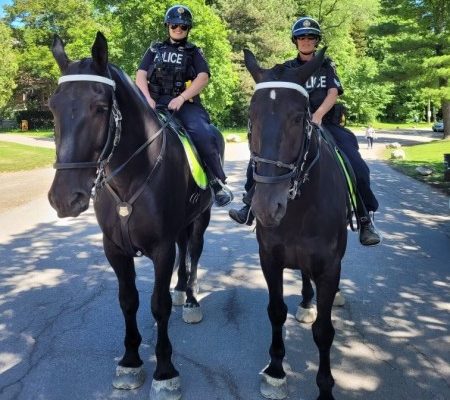New horses ‘up for the challenge’ as they join Hamilton police unit
Published June 28, 2023 at 9:00 am

One is like an “old, wise” man and the other is “playful” and “mighty.”
Both four-legged recruits just got their Hamilton police badges, slowly hitting the streets to help the force serve and protect the community.
Sgt. Denise Leonard, who is in charge of the city’s Mounted Patrol Unit, which was formed in January 2010, said Hamilton police have been training geldings Sawyer and Sutherland to get used to the roads and their duties.
The black horses, acquired from private sellers, got their police badges earlier this month in a ceremony welcoming them to the force.
The Mounted Patrol Unit’s officers have the same uniforms and “use of force options” as others in the force, only they ride horses. The unit’s officers receive training on horsemanship, riding skills and roadwork.
You won’t usually see the mounted unit responding to violent incidents such as shootings, but they do other important work, says Leonard.
“Our horses do general patrol, which means they just patrol the streets,” said Leonard in a phone interview with hamilton.insauga.com. “We can give out tickets, we can make arrests, but it’s not the bulk of what we do. We do high visibility patrols, reassurance patrols, search and rescue, public order, community events, formal events.”
In areas with high crime, the mounted unit does high visibility patrols to obtain information, for example. “So sometimes we can get witnesses to crime, sometimes people give us information about crimes that are happening in an area.”

Hamilton mounted police’s Sawyer, 16, is a Percheron horse. COURTESY HAMILTON POLICE SERVICE
Sawyer is ‘the old, wise horse,’ says head of mounted unit
The police acquired Sawyer from a local horse dealer in Flamborough in August 2022, said Leonard. He is a full Percheron, a French draft breed generally used for ploughing fields and pulling farm equipment such as wagons. The breed is known to be gentle, agile and energetic. At about 18 hands tall (72 inches), Sawyer is taller than Sutherland, who is 17 hands tall (68 inches).
“Sawyer, he’s a really majestic horse, he’s really got a really nice look to him,” Leonard told hamilton.insauga.com, noting Sawyer is a more mature horse at 16 years old. “He’s got a kind personality. He’s like the old, wise horse.”
What makes Sawyer wise? Leonard explains with a laugh that “he won’t do any more work than he has to.”
“(Sawyer is) just more mature, has less energy and just wiser in how much effort he puts into something,” she explained. “Like we would be as we get older, we work a little smarter.”

Hamilton mounted police’s Sutherland is a five-year-old Percheron thoroughbred cross. COURTESY HAMILTON POLICE SERVICE
Younger horse Sutherland known to be ‘playful’ and ‘mighty’
The police acquired Sutherland from an Ottawa seller this February, Leonard said. He’s a five-year-old Percheron thoroughbred cross, a breed used in thoroughbred racing. However, in his role with the unit, he will be helping police patrol areas rather than racing in the streets.
“He’s playful ‘cause he’s younger,” she said. “Even though he’s a bit smaller, he acts like the other horses, like he’s got a strong will and he’s mighty.”
If Sutherland is not sure of something, he won’t be afraid to stand there and try to figure it out instead of immediately running away, Leonard explained.
She said the force didn’t pay a “crazy amount” for the horses. She could not disclose the amount.
View this post on Instagram
Typical day for mounted unit’s horses
The horses work four days a week, with officers riding them from 9 a.m. to 4 p.m., with two breaks in between three-hour patrols. They are fed breakfast before they start their day and given water when they need it. They don’t usually need to eat hay during their shift, unless they are involved in an intense task, said Leonard.
During day shifts, officers check what happened overnight and see if there are any requests for them to do patrols, such as for searches. The horses are driven by a truck and trailer to areas where they will patrol. They usually patrol downtown or in the business improvement areas if they have no specific places to go. For night shifts, they patrol the entertainment areas downtown or any events.
“Riding in the core, highly populated areas, it’s a lot of reassurance when officers are down there,” Leonard said. “People can see the police ‘cause we’re high visibility, so if there’s nothing specific for us to do, then we’ll do that type of patrol.”
It’s hot. Don’t forget to stay hydrated #Hamont; even if that means not waiting till the bucket is full. pic.twitter.com/os3ai6rcXY
— HPS Mounted Patrol (@HPSMounted) June 19, 2020
The horses live in a training facility in Lynden, Ont., where a barn manager is responsible for day-to-day care, however, officers also care for their horses.
During the weekend, the horses are able to roam and run around large fields and rest in their big pens, she said.
The horses generally live for around 25 to 30 years, though sometimes the force may lose a horse. In July 2022, the unit announced that it had lost Argyll, a seven-year-old Percheron Cross, after an accidental injury while he was off duty. He was named after The Argyll and Sutherland Highlanders of Canada (Princess Louise’s).

The Hamilton mounted unit’s Argyll, a seven-year-old Percheron Cross, died after an accidental injury while he was off duty in July 2022. COURTESY HAMILTON POLICE SERVICE
A ‘memorable’ pandemic birthday and catching a copper thief
Leonard recalled that a mother approached her with her young daughter at a recent event to tell her how two officers riding their horses sang happy birthday to her daughter and let her pet the horse, making her daughter’s pandemic birthday memorable. Since it was during the early days of COVID in 2020, her daughter could not have a party so they had family drive by honking and waving for her birthday. “It was cute because actually I was one of the officers that was there,” she said. “It was really nice because she said it was the best thing that happened and it was her most memorable birthday memory.”
The mounted unit won’t likely be in the middle of shootouts, but sometimes they can find themselves in stickier-than-normal situations. Leonard said over a year ago, she and another officer were called to help capture someone stealing copper wire from the railyard. They were riding their horses in the area so they teamed up with another officer who was in a cruiser. The two officers with their horses cantered in behind the thief and the three officers were able to surround him in the railyard.
“We wouldn’t necessarily be your first response,” she said. “We’re not fast normally … So we could be looking for witnesses, speaking to witnesses, we could be on a perimeter point. We wouldn’t be right in the middle of it, but we certainly could be utilized around it.”
View this post on Instagram
The mounted unit could be deployed to help in searches if somebody goes missing in the city or in rural areas. “So if it’s in a rural area, sometimes there’s terrain we can navigate easier, we cover more ground than a foot officer would,” she said. “Some of ATVs are noisy whereas with horses we can hear somebody when we’re covering that ground. We have a height advantage to see farther ‘cause we’re up higher.”
Horses can make it easier when it comes to those situations. “A lot of times when people are missing, if they fear any reprisal, let’s say if a child has run away, they won’t necessarily come out to the police, but they will come out to see the horses,” Leonard explained. “Same with people that have dementia and other issues, they tend to come and be drawn to the horses.”
View this post on Instagram
Police horses are ‘pretty chill’
The horses’ training could typically take up to a year or three years because “we have to get them sensitized to all the different noises they’re going to be involved with driving in a truck and trailer,” Leonard said.
She added that the horses usually are “pretty chill.”
“There’s a lot to train but we use positive reinforcement training so they enjoy their work,” she said. “Both of them seem up for the challenge.”
INthehammer's Editorial Standards and Policies
View this post on Instagram





